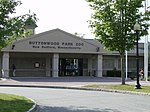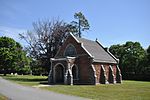Buttonwood Park Historic District
Historic districts in Bristol County, MassachusettsHistoric districts on the National Register of Historic Places in MassachusettsNRHP infobox with nocatNational Register of Historic Places in New Bedford, MassachusettsNew Bedford, Massachusetts ... and 2 more
Parks in Bristol County, MassachusettsUse mdy dates from August 2023

Buttonwood Park Historic District is a historic district on Kempton Street, Rockdale Avenue, Hawthorne Street and Brownell Avenue in New Bedford, Massachusetts. Its focal point is Buttonwood Park, a 97-acre (39 ha) municipal park planned by Charles Eliot in the 1890s, and part of its surrounding neighborhood. The neighborhood was developed in the first decades of the 20th century as a complement to the park, and contains a fine selection of Colonial Revival and Craftsman style houses. The district was added to the National Register of Historic Places in 2000.
Excerpt from the Wikipedia article Buttonwood Park Historic District (License: CC BY-SA 3.0, Authors, Images).Buttonwood Park Historic District
William Saltzman Way, New Bedford
Geographical coordinates (GPS) Address Nearby Places Show on map
Geographical coordinates (GPS)
| Latitude | Longitude |
|---|---|
| N 41.631944444444 ° | E -70.951944444444 ° |
Address
William Saltzman Way
William Saltzman Way
02740 New Bedford
Massachusetts, United States
Open on Google Maps







